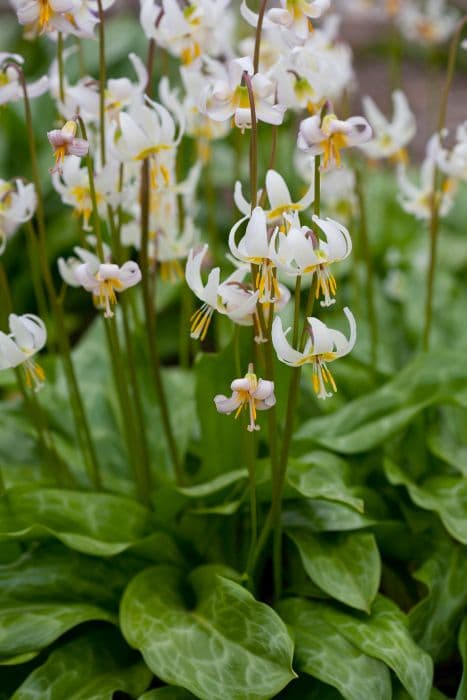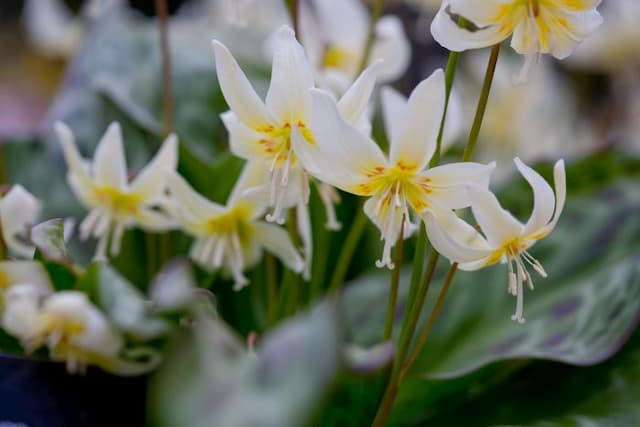Lily Pink Perfection Lilium Pink Perfection Group (Vib/a)

ABOUT
The Pink Perfection lily is a striking plant known for its elegant and vibrant flowers. It boasts large, trumpet-shaped blooms that are a deep, rose-pink color, often with a paler, softer pink or white edge. The blooms have a recurved shape, curving back towards the stem, creating a dramatic and exotic appearance. Each petal is adorned with darker pink spots and lines, a common trait in these types of lilies which adds to their ornate look. The flowers are borne on long, firm stems which are surrounded by lance-shaped green leaves that spiral around the stem, adding to the plant's aesthetic with their lush configuration. The foliage is typically a bright, glossy green, providing a rich backdrop that contrasts beautifully with the vivid pink of the flowers. During the blooming season, the Pink Perfection lily exudes a strong, sweet fragrance that is particularly noticeable on warm evenings. This scent makes the plant not only a visual standout in the garden but also a contributor to its sensory appeal. With its showy blossoms and aromatic presence, the Pink Perfection lily is often a favorite among gardeners looking to add a touch of elegance and fragrance to their outdoor spaces.
About this plant
 Names
NamesFamily
Liliaceae
Synonyms
Pink Perfection Lily, Pink Perfection Trumpet Lily
Common names
Lilium Pink Perfection Group
 Toxicity
ToxicityTo humans
The Lilium Pink Perfection Group, commonly known as the lily, is not highly toxic to humans. However, ingesting parts of the lily, especially in large quantities, can cause mild digestive upset, such as nausea, vomiting, or diarrhea. It is rare for severe poisoning or life-threatening symptoms to occur in humans from ingesting parts of a lily. If you suspect poisoning, it is important to seek medical advice.
To pets
Lilies, including those of the Lilium Pink Perfection Group, are highly toxic to cats and can result in severe kidney damage or failure if ingested. Even small amounts of the plant, such as a few petals or leaves, pollen, or water from a vase holding the flowers can cause lethargy, vomiting, and a loss of appetite. Without prompt veterinary treatment, symptoms can progress to kidney failure, which can be fatal. Dogs are less susceptible to lily poisoning, but ingestion can still cause mild to moderate gastrointestinal upset. It is crucial for pet owners to keep lilies out of reach of their pets, especially cats, and to seek immediate veterinary care if ingestion is suspected.
 Characteristics
CharacteristicsLife cycle
Perennials
Foliage type
Deciduous
Color of leaves
Green
Flower color
Pink
Height
4 feet (1.2 meters)
Spread
1 foot (0.3 meters)
Plant type
Bulb
Hardiness zones
4
Native area
Asia
Benefits
 General Benefits
General Benefits- Aesthetic Appeal: The Lilium Pink Perfection, commonly known as the Lily, offers striking pink blossoms that enhance the visual beauty of gardens and landscapes.
- Pollinator Attraction: Lilies attract beneficial pollinators like bees and butterflies, which are essential for the pollination of many plants and crops.
- Fragrance: They emit a pleasant fragrance that can add a delightful scent to outdoor spaces and cut flower arrangements.
- Versatility: Lilies are versatile and can be planted in flower beds, borders, or containers, making them suitable for various garden designs and sizes.
- Cut Flowers: They make excellent cut flowers with a long vase life, perfect for floral arrangements and bouquets.
- Seasonal Interest: Lilies bloom during the summer, providing seasonal interest and color when many other plants have finished flowering.
 Medical Properties
Medical PropertiesThis plant is not used for medical purposes.
 Air-purifying Qualities
Air-purifying QualitiesThis plant is not specifically known for air purifying qualities.
 Other Uses
Other Uses- Lilium Pink Perfection bulbs can be ground to create a starch-like flour, which is occasionally added to food products or as a thickener in sauces.
- The sturdy stems of Lilium Pink Perfection can be used as natural supports for other, less rigid plants in the garden.
- The petals of the Pink Perfection lily, while not commonly used for this purpose, can be crystallized and used as edible decorations on desserts.
- Dried Pink Perfection lily petals can be incorporated into potpourri mixes for a subtle floral fragrance.
- These lilies could potentially be used in dye production, as many flowers have pigments that can be used to color fabrics or paper.
- With their tall, elegant appearance, Pink Perfection lilies can serve as a natural fence or privacy screen when planted in a dense row.
- Because of their bright color, the petals could be used in crafts, such as flower pressing, to create unique artwork or bookmarks.
- The Pink Perfection lily's large, vibrant blooms make excellent natural dyes for customizing clothing or linens.
- In some cultures, various parts of lilies are added to compost or used as mulch due to their nutrient content and ability to decompose well.
- The Pink Perfection lily is sometimes incorporated in landscape design as a means to direct foot traffic, using their placement to guide visitors along a desired path.
Interesting Facts
 Feng Shui
Feng ShuiThe Lily is not used in Feng Shui practice.
 Zodiac Sign Compitability
Zodiac Sign CompitabilityThe Lily is not used in astrology practice.
 Plant Symbolism
Plant Symbolism- Passion: The deep pink color often represents intense passion and deep emotion.
- Rarity and Perfection: The name "Pink Perfection" itself suggests a level of excellence and exquisite rarity.
- Beauty and Elegance: Lilies in general symbolize beauty, and with the lush fullness of its petals, the Pink Perfection variety epitomizes grace and sophistication.
- Femininity: The soft hue of pink is traditionally associated with feminine qualities and maternal love.
- Transformation: A lily's growth from a bulb to a stunning flower symbolizes growth and the idea that beauty can emerge from unexpected places.
- Renewal: Lilies are often associated with rebirth and renewal, as they return beautifully each season.
 Water
WaterThe Oriental Lily, commonly known as the Pink Perfection Lily, thrives when watered deeply and thoroughly, allowing the soil to become slightly dry between waterings. Aim for at least 1 inch of water weekly, and during hot, dry spells, increase watering frequency to maintain evenly moist soil. It's crucial not to overwater, as this can lead to root rot. Assess soil moisture by feeling the top inch of soil; if it's dry, it's time to water again. Watering with approximately 1 gallon of water per week is typically sufficient, but adjust for rainfall and temperature conditions.
 Light
LightThe Pink Perfection Lily requires a location where it receives full sun to part shade for optimal growth. An ideal spot would ensure that it gets at least six hours of direct sunlight daily, though some afternoon shade can be beneficial in extremely hot climates. Avoid placing it in deep shade, as this will hinder its flowering and overall health.
 Temperature
TemperaturePink Perfection Lilies thrive in temperatures ranging from 59 to 77 degrees Fahrenheit. The ideal range encourages robust growth and flowering. They can withstand extremes from just above freezing up to about 86 degrees Fahrenheit, but prolonged exposure outside this range can be detrimental to the plant. Protecting the lilies from extreme temperature fluctuations is essential to maintain plant health.
 Pruning
PruningPruning Pink Perfection Lilies is primarily for aesthetic purposes and to remove spent flowers, promoting the growth of new buds and maintaining plant vigor. Deadhead the flowers as they fade, and after flowering is complete, cut back the stems to just above a healthy set of leaves. Pruning should be done annually, and the best time for this is in late fall or after the first frost to prepare the plant for dormancy.
 Cleaning
CleaningAs needed
 Soil
SoilThe best soil mix for the Oriental Lily 'Pink Perfection' should be well-draining, rich, and loamy. It is important to mix in organic matter such as compost or peat moss to improve soil structure. A slightly acidic to neutral pH of 6.5 to 7.0 is ideal for this lily's growth and flowering.
 Repotting
RepottingOriental Lilies, including 'Pink Perfection', generally do not need to be repotted often. They should be repotted every 3 to 4 years or when the bulb outgrows its current pot or shows signs of decreased flowering.
 Humidity & Misting
Humidity & MistingOriental Lilies like 'Pink Perfection' prefer moderate humidity levels. Aim for a humidity level of around 40% to 60% to keep these lilies happy.
 Suitable locations
Suitable locationsIndoor
Use well-draining soil, bright indirect light, and moderate watering for 'Pink Perfection'.
Outdoor
Plant in well-drained soil and full sun to partial shade for best bloom.
Hardiness zone
4-9 USDA
 Life cycle
Life cycleThe Lilium Pink Perfection, commonly known as the Pink Perfection lily, begins its life cycle as a bulb, which overwinters underground in colder climates. In spring, shoots emerge from the bulb, developing into a sturdy stem with long, lanceolate leaves. Throughout spring and early summer, the plant continues to grow, reaching up to 6 feet tall for some varieties. By midsummer, trumpet-shaped, fragrant pink flowers bloom at the top of the stem, attracting pollinators such as bees and butterflies. After pollination, the flowers give way to seed pods if fertilization occurs; these pods will eventually dry and release their seeds, which can germinate to produce new plants. As the growing season ends, the Pink Perfection lily's foliage dies back, and the plant enters dormancy, with the bulb storing energy until the next growth cycle begins.
 Propogation
PropogationPropogation time
Spring-Early Summer
The most popular method of propagation for the Lilium Pink Perfection, more commonly known as the Pink Perfection Lily, is by dividing its bulbs. This is typically best done in the fall, after the foliage has died back, or in the early spring before new growth begins. To propagate by bulb division, carefully dig up the mature clump of lilies, ensuring to minimize damage to the bulbs and roots. Gently separate the bulbs at the natural division points, being cautious not to tear them apart forcefully. Each section should have at least one bud or stem attached to it. Replant the bulbs immediately, at a depth of around 4 to 6 inches (10 to 15 centimeters), in well-draining soil and at a location with sufficient sunlight. Water the newly planted bulbs thoroughly to help them establish in their new locations.









